Non-agricultural seasonal and temporary migrant workers in urban and rural Scotland: report
Report providing an estimate of the proportion of seasonal migrant workers outside of the agricultural sector in Scotland and information on the living and working conditions of non-agricultural seasonal migrant workers in rural and urban Scotland.
Appendix A: Economic and Data Modelling
This analysis seeks to understand the sectoral pattern of non-native employment in Scotland. The objective is to understand the sectors in which non-native employees work, with the aim of shedding light on where seasonal non-agricultural migrant workers may be employed.
In particular, the Labour Force Survey (LFS), the principal labour market survey in the UK, and the APS which can be thought of as an annual version of the LFS (making use of the same data) but more robust to sub—national analysis, and smample private households. By definition therefore seasonal migrant workers – who tend to reside in hotels and caravan parks– will not be in these surveys.
What is employment in the UK and Scotland like, in terms of industries and occupations?
SCT03202264581 shows the mix of employment in the UK and Scotland by broad industrial sector. The proportions are essentially the same between 2012 and 2017. On this basis the UK and Scottish economies are not that different.
We have used data from 2017 as this was the latest data available at the time of the analysis; a 5 year trend is shown to enable comparison of the results over time.
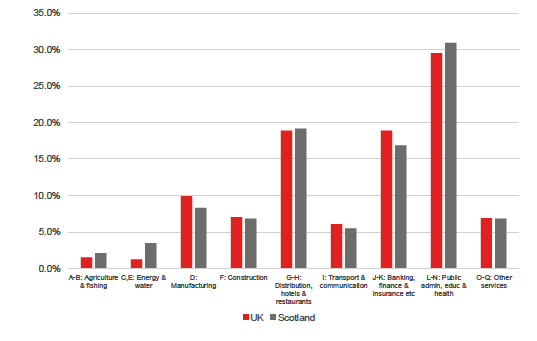
Source: ONS, Annual Population Survey, January to December
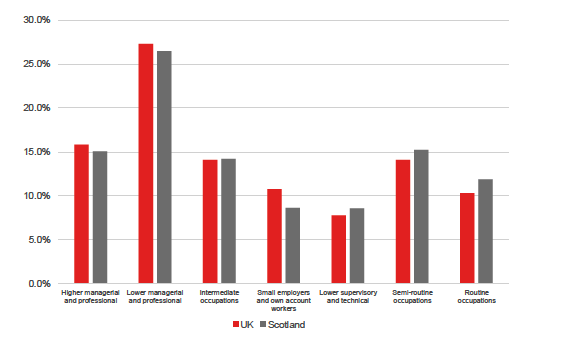
Source: ONS, Annual Population Survey, January to December
We can look at the same information, but with employment split out by occupation. This is shown in Figure 2 for 2017, however other years are similar.
Again here we can see that the occupational mix of employment in Scotland is not that much different to the UK as a whole. The proportion of workers in managerial and professional occupation is slightly higher in the UK as a whole, and the proportion of routine and semi-routine jobs slightly lower, but the overall pattern is similar (and any differences are unlikely to be statistically significant).
What do we know about where non-UK born employees are working?
Figure 3 shows employment of non-UK born workers by industrial sector in 2017, and Figure 4 shows this information broken down by occupation. We can see that there is a greater concentration of workers in 'Distribution, hotels & restaurants' and 'Banking, finance & insurance, etc.', while the occupational mix does not seem that different to the overall UK labour market.
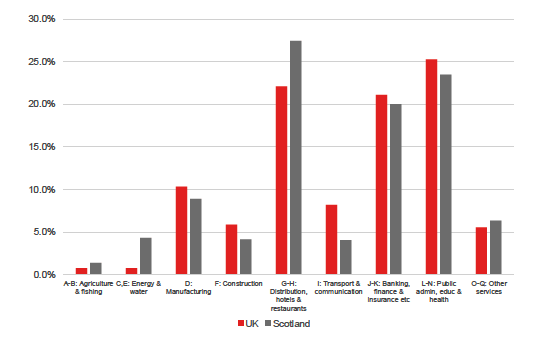
Source: ONS, Annual Population Survey, January to December
These data relate to all non-UK born employees, and for this project we are mostly interested in lower skilled occupations which are more amenable to seasonal work.
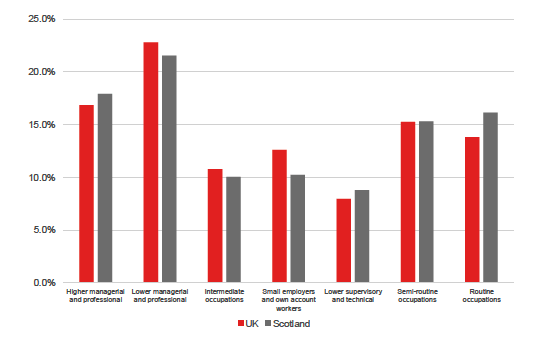
Source: ONS, Annual Population Survey, January to December
In order to capture this, in Figure 5 we recreate Figure 3 focussing in on those doing 'lower supervisory and technical occupations', 'semi-routine occupations' and 'routine occupations', to proxy for low-skilled occupations.
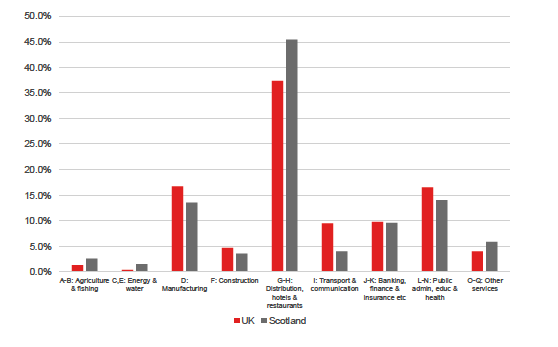
Source: ONS, Annual Population Survey, January to December
Comparing Figure 3 and Figure 5 we can see that focussing in on those in lower skilled work increases the proportion of non-UK born workers in Scotland working in Distribution, hotels and restaurants from 27% to 45%.
What do we know about where non-UK national employees are working?
In this case, we focus instead on those who list their nationality as not being the UK, as opposed to their country of birth.The key reason for this is that we are focussed in this work on the employment of migrants to the UK, and therefore we focus on those who are non-UK national as opposed to those not born in the UK (but who may have subsequently become UK nationals).
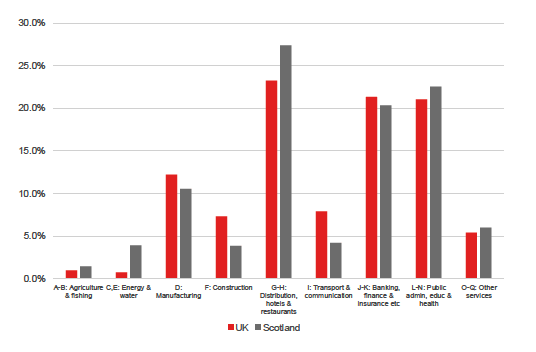
Source: ONS, Annual Population Survey, January to December
Comparing Figure 4 and Figure 6, and Figure 5 and Figure 7, we can see that the pattern of employment by sector and occupation across non-UK born and non-UK nationals are broadly similar.
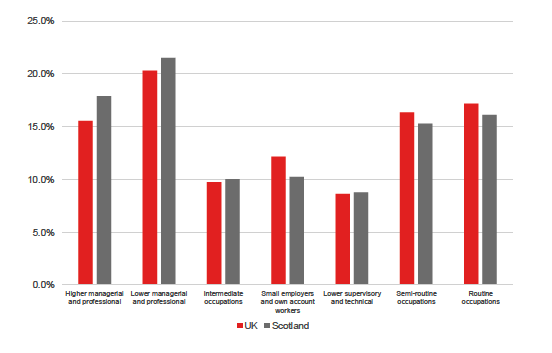
Source: ONS, Annual Population Survey, January to December
We can again narrow our focus to those in lower skilled occupations, and we do this in Figure 8 below.
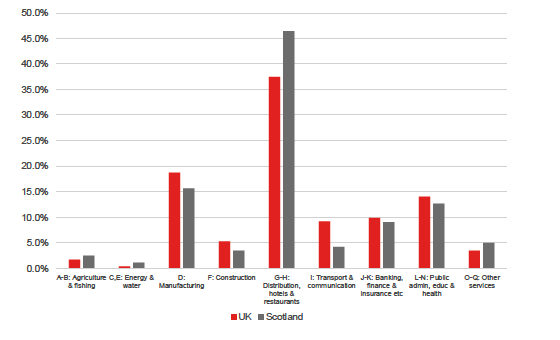
Source: ONS, Annual Population Survey, January to December
We can also consider where more recent migrants to the UK are employed. We do this by considering those who have arrived in the UK in the last 5 years (using the survey data up to 2017 means that we consider migrants arriving from 2012 onwards).
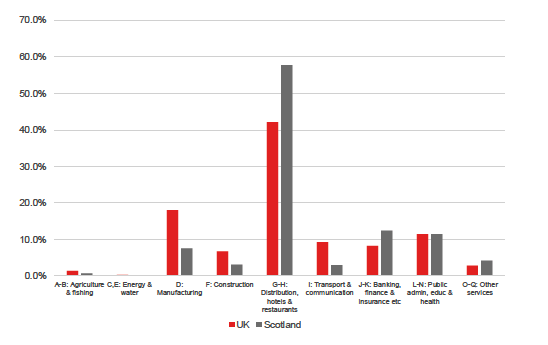
Source: ONS, Annual Population Survey, January to December
It is worth cautioning that at this level of detail, focusing in on non-UK nationals, in lower skilled occupations, in Scotland, who arrived in the UK from 2012 onwards, the annual survey data start to become less reliable with some sectoral level estimates fluctuating substantially between years.
Therefore we pool the data for the period 2012-2017, and report a summary of those sectors where non-UK nationals arriving in the UK since 2012 and working in "low skilled" occupations in Scotland are employed – Figure 10.
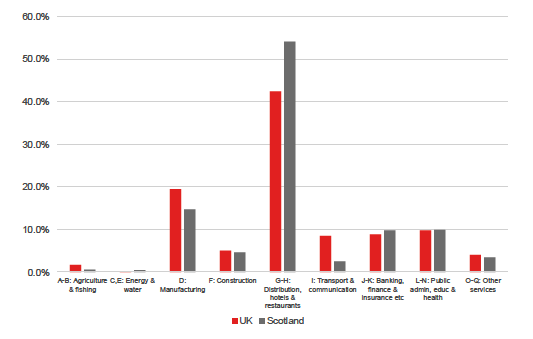
Source: ONS, Annual Population Survey, 2012-2017
The general pattern of Figure 9 is preserved, with perhaps slightly less focus on some sectors than before, but it is still clear that most of the recent arrivals into Scotland from outside the UK are working in the 'Distribution, hotels and restaurants' sector.
What do we know about employment in the Distribution, hotels and restaurants sector?
The relative share of those working in the two component sectors (G and H) of the dominant employer of "low skilled" non-UK born or UK-national employees is relatively constant and even across this period in Scotland. Figure 11 shows the trend in employment in these disaggregate sectors.
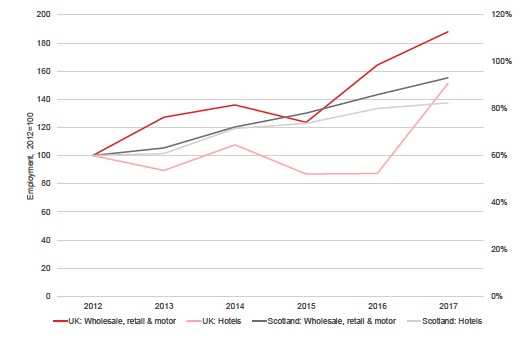
Source: ONS, Annual Population Survey, 2012-2017
Another way to look at this is to focus on where non-UK nationals or UK born employees are working in less permanent work arrangements
Figure 12 below shows the %-shares of employment of non-UK nationals in "low skilled" occupations by sector. Again, as before, when considering the Scottish data the quality of the sample is an issue, with substantial volatility in the estimates between years. Figure 13 illustrates this issue. Because of this volatility Figure 12 presents the data pooled over the 2012-2017 period.
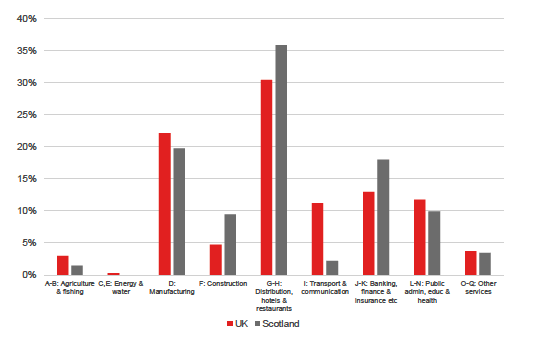
Source: ONS, Annual Population Survey, 2012-2017
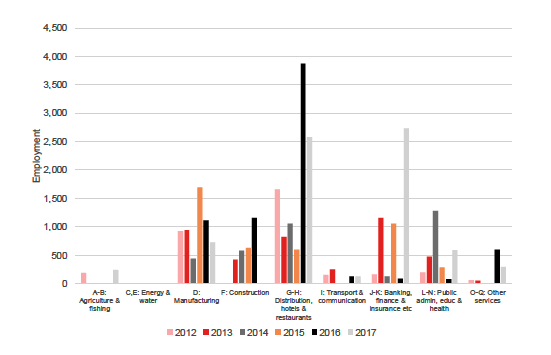
Source: ONS, Annual Population Survey, 2012-2017
Are those non-UK nationals working in "low skilled" jobs, working for large or small employers in each sector?
Figure 14 shows employment by sector of non-UK nationals working in "low skilled" occupations by self-reported size of their company. For the same sample size and robustness reason as before, given that we are now going quite specific within the Scottish labour market (selecting by skill, non-UK born, sectoral and by firm size) we pool the sample over 2012-2017 to provide a better sense of where these workers are employed.
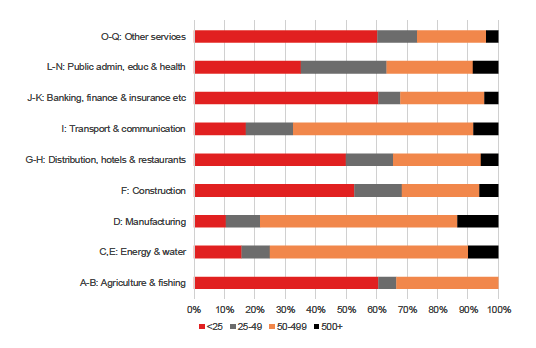
Source: ONS, Annual Population Survey, 2012-2017
We can focus further into the sector G-H which we saw earlier are particularly important for this study.
We can see in Figure 15 that larger businesses are a more important employer in the 'Wholesale, retail and motor trade' sector than in the Hotels sector for this type of worker. However one in three non-UK national workers employed in wholesale, retail and motor trade are working for employers with fewer than 25 employees.
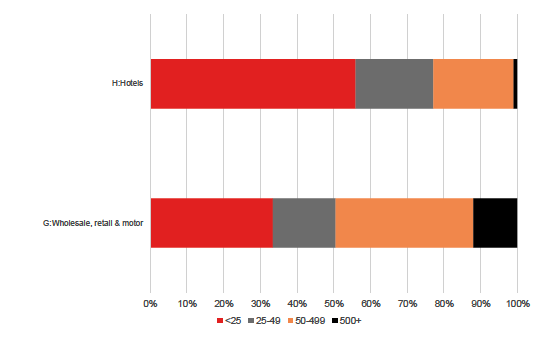
Source: ONS, Annual Population Survey, 2012-2017
What do the National Insurance registration data tell us about the location of new arrivals?
The Department for Work and Pensions release data on quarterly National Insurance (NI) number registrations for adult overseas nationals, broken down by local authority.
The trends in these NI registrations in each local authority between 2002 – 2018 are shown in Figure 16 below.
It is clear than almost all local authority areas are seeing a substantially higher number of NI registrations to overseas nationals in 2018 than they had in 2002.
There are 5 local authority areas which are notable. The first is Angus which has seen a sustained pattern of increasing NI registrations for overseas nationals, as has Perth & Kinross, over this period. Aberdeenshire also appears to be seeing a higher than average growth in the number of NI numbers being issues to overseas nationals.
Shetland stands out largely because of a spike in registrations in 2014. It is not clear what this is driven by, although activity in the North Sea would be an obvious candidate.
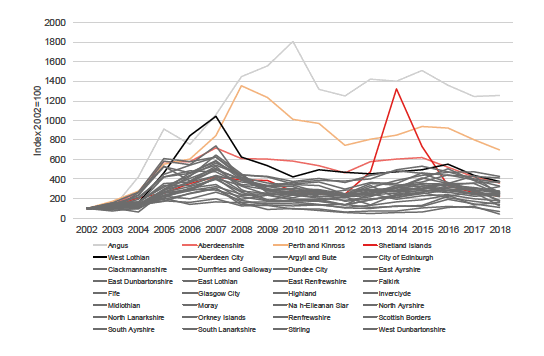
Source: Department for Work and Pensions (DWP)
Because of the quarterly nature of these data, they enable us to explore the seasonal pattern of National Insurance registrations to overseas nationals by local authority, helping to identify where in Scotland there is a distinct seasonal pattern to these registrations.
In Figure 17 below, we examine quarterly NI number registrations by local authority compared to the average annual number of registrations in each local authority. This approach helps us identify the areas with distinct seasonal patterns, with those local authorities with less seasonality having values close to zero.
Figure 17 is based on data from 2010 onwards, although data over the whole period which is available (2002—2018) show a very similar pattern. There is a substantial seasonal increase in NI registrations for overseas nationals in Q3 in Perth & Kinross, Angus, and Fife, and to a lesser extent in Highland, Edinburgh and Aberdeenshire. This is likely tied to seasonal agricultural activities and tourism. The major cities see a spike in NI registrations for overseas nationals in the final three months of the year, with Aberdeen, Edinburgh, and Glasgow seeing substantially higher registrations in Q4 of each year – perhaps tied to international students registering to work, and/or increased activity in the retail sector around the festive season.
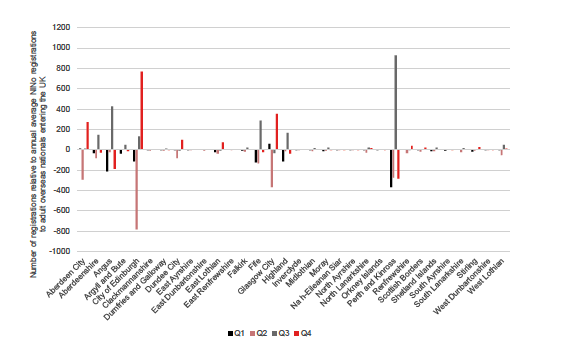
Source: DWP
Summary
Data on migrant workers in the UK is not available in any of the standard labour market surveys.
However, by exploring trends in employment among non-native workers employed in lower skilled occupations, this report has sought to shed light on the sectors in which such workers may be employed.
We can see a clear pattern of these types of employees working in the hotel and restaurant sector. When we look at the sizes of these firms that people are working in many of these are small firms, with fewer than 25 employees.
Looking at the data on NI registrations by local authority has helped shed light on the seasonal pattern of migrant work in general, and the location of much of this migrant work.
In this case it appears that much of the seasonal migrant work is concentrated in Q3 and Q4 of the year, with more rural and agricultural parts of the country experiencing growth in employment in Q3 and major cities experiencing greater growth of migrant worker NINo registrations in Q4.
Contact
Email: socialresearch@gov.scot
There is a problem
Thanks for your feedback